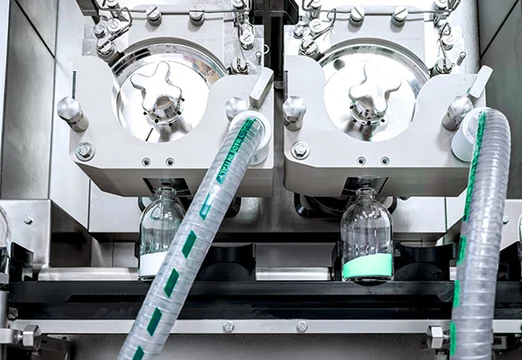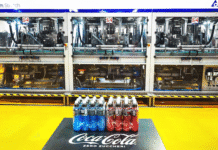Packaging is a critical aspect of product marketing and preservation, and in the realm of powdered products, the choice of packaging material plays a crucial role. This article explores the various roles film plays in powder packaging, highlighting its importance, benefits and critical factors to be considered for machine performance especially when changing to more sustainable and recyclable materials.
Pouch packaging has become a popular choice for packaging powdered goods due to its versatility, cost-effectiveness, and ability to protect the product from external factors. One of the primary roles of film in powder packaging is to protect the product from external elements that could compromise its quality.
Protection and preservation
Film provides a barrier against moisture, light, oxygen, and other contaminants, thereby preserving the freshness and integrity of the powdered product. This is especially important for powdered goods that are sensitive to moisture or oxidation, such as powdered food products and pharmaceuticals.
Extended shelf life
Pouch packaging helps extend the shelf life of powdered products by creating a protective barrier that prevents spoilage. By keeping out moisture and oxygen, pouch packaging helps maintain the product’s quality and freshness for a longer period, reducing the risk of spoilage and increasing the product’s shelf appeal to consumers.
Product visibility and marketing
Pouch packaging offers excellent visibility for the product, allowing consumers to see the contents clearly. This is particularly advantageous for powdered products, as it allows consumers to inspect the product before purchase, enhancing consumer trust and confidence. Additionally, film packaging can be printed with vibrant designs and branding, making the product more attractive to consumers and helping to differentiate it from competitors on the shelf.
Convenience and portability
Pouch packaging is lightweight and easy to handle, making it convenient for both manufacturers and consumers. For manufacturers, pouch packaging is easy to transport and store, reducing logistics costs. For consumers, film packaging is easy to open and reseal, allowing for convenient storage and use of the powdered product.
Sustainability
Pouch packaging can be made from a variety of materials, including recyclable and biodegradable options, making it a sustainable choice for powder packaging. By choosing environmentally friendly film materials, manufacturers can reduce their environmental impact and appeal to consumers who are increasingly concerned about sustainability.
In conclusion, film plays a crucial role in powder packaging, offering a range of benefits such as protection, preservation, extended shelf life, product visibility, convenience, and sustainability. By choosing the right film packaging material and design, manufacturers can enhance the appeal and marketability of their powdered products, ultimately leading to increased sales and consumer satisfaction.
In addition, it is important to take into consideration cost and machine performance. Some of the critical machine interface issues to be looked at are given below.
Hot tack curve
The hot tack curve refers to the heat-sealing characteristics of a packaging material. It describes how the material behaves when subjected to heat during the sealing process. A well-defined hot tack curve is essential for ensuring proper sealing and preventing leaks or contamination of the packaged product.
The film manufacturer specifies the pressure and temperature to be set for maximum seal strength, crucial to withstand handling of the package during distribution. In addition, the film supplier specifies the maximum temperature gradient the film can take. This will ensure uniform sealing and good aesthetic appearance subject to the machine sealers operating within that band.
Coefficient of friction (COF)
The coefficient of friction is a measure of the ease with which two surfaces slide against each other. In packaging, the COF of a film material is crucial for determining its suitability for use on packaging machines. A low COF will require additional pressure to pull the film thereby causing pull belt wear. Vacuum pull belts are recommended if the film COF is low. You must be aware of these values (hot tack and COF) and they must be discussed with the film supplier.
Eye mark color
Eye marks are used in packaging to indicate where a machine should perform a specific action, such as cutting or sealing. The color of the eye mark is important for machine vision systems to accurately detect and interpret the mark, ensuring precise and consistent packaging.
Sealing layer material and thickness
The sealing layer of a packaging material is responsible for creating a secure seal to protect the contents. The material and thickness of the sealing layer are critical factors that affect the strength and integrity of the seal. The right combination of material and thickness is essential to prevent leaks and maintain the freshness of the packaged product.
Monolayer versus laminate packaging
Monolayer packaging consists of a single layer of material, while laminate packaging consists of multiple layers bonded together. The choice between monolayer and laminate packaging depends on the specific requirements of the packaged product. Monolayer packaging is often more cost-effective, while laminate packaging offers enhanced barrier properties and strength.
Sustainable films
This is the topic of the day. Finding alternative films that meet the objective of shelf life and cost is the primary focus for most organizations. While these are very important, it is imperative that the existing equipment can run on the new film. Especially at the current performance levels.
It is therefore important to involve the machine supplier at the beginning of the journey which unfortunately is not the case with most organisations. Film selection and machine performance cannot be two individual silos.
A business needs a package that has a point of purchase value, that can be delivered and can sustain the supply chain and offer the customer desired shelf life. It is imperative that a proper interface is found between the machine and the film.












